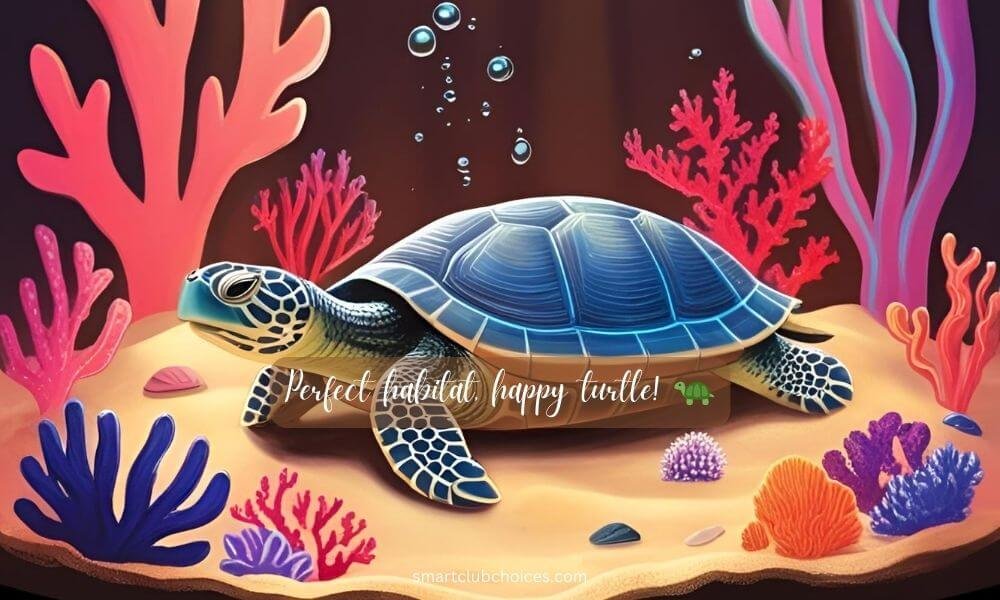Creating a Natural Habitat for Your Turtle
Turtles are more than just pets—they’re little adventurers with a deep connection to their natural environment.
Whether they’re basking in the sun, swimming in a pond, or digging in the dirt, turtles thrive when their surroundings mimic the wild.
But how do you bring the great outdoors into your home (or backyard)? Don’t worry, you don’t need to be a nature expert or a DIY guru to create a natural habitat for your turtle.
In this guide, we’ll show you how to replicate your turtle’s natural environment in a tank or outdoor pond. Let’s get started!
Table of Contents
(1) The Basics – Understanding Your Turtle’s Natural Habitat
Why a Natural Habitat Matters
- Health: A natural environment supports your turtle’s physical and mental well-being.
- Happiness: Turtles are more active and less stressed when their surroundings feel familiar.
- Enrichment: A natural habitat provides opportunities for exploration, digging, and basking.
What Does “Natural” Mean for Your Turtle?
- Aquatic Turtles: Think ponds, rivers, and lakes—plenty of water, plants, and basking spots.
- Semi-Aquatic Turtles: A mix of water and land, with areas for swimming, digging, and hiding.
- Tortoises: Dry, sandy, or grassy environments with plenty of space to roam.
(2) Setting Up an Indoor Tank – Bringing the Outdoors In
Choosing the Right Tank
- Size: Bigger is always better. Aim for at least 10 gallons of water per inch of turtle shell.
- Shape: A long, shallow tank is ideal for turtles, as it provides more swimming and basking space.
Creating the Perfect Environment
- Water Area: Use a strong filter to keep the water clean and add aquatic plants like Java fern or Anubias.
- Basking Area: Include a dry platform with a heat lamp and UVB light. Add rocks or logs for climbing.
- Substrate: Use large, smooth gravel or sand for the bottom of the tank. Avoid small gravel, which can be a choking hazard.
Pro Tip
Add hiding spots like caves or PVC pipes to give your turtle a sense of security.
(3) Building an Outdoor Pond – A Slice of the Wild
Why an Outdoor Pond?
An outdoor pond allows your turtle to experience natural sunlight, fresh air, and a more varied environment.
How to Build a Turtle Pond
- Choose a Location: Pick a spot with partial sun and shade to regulate temperature.
- Dig the Pond: Make it at least 2-3 feet deep with sloping sides for easy entry and exit.
- Line the Pond: Use a pond liner to prevent leaks and add a layer of sand or gravel for a natural look.
- Add Water and Plants: Fill the pond with dechlorinated water and add aquatic plants like water lilies or duckweed.
- Create a Basking Area: Include rocks, logs, or a floating platform for your turtle to bask on.
Pro Tip
Add a fence or netting around the pond to protect your turtle from predators.
(4) Adding Natural Elements – The Fun Part
Plants
- Aquatic Plants: Water hyacinth, water lettuce, and hornwort are great for tanks and ponds.
- Land Plants: For tortoises, add edible plants like dandelions, clover, or grass.
Rocks and Logs
- Rocks: Use smooth, flat rocks for basking and climbing.
- Logs: Driftwood or cork bark can provide hiding spots and climbing opportunities.
Substrate
- Sand: Ideal for digging and burrowing.
- Gravel: Use large, smooth gravel for aquatic setups.
Pro Tip
Rotate decor items occasionally to keep your turtle’s environment fresh and interesting.
(5) Maintaining the Habitat – Keeping It Clean and Safe
Water Quality
- Filtration: Use a strong filter to keep the water clean.
- Water Changes: Perform partial water changes weekly and full changes monthly.
Temperature and Lighting
- Heat Lamp: Keep the basking area warm (around 90-95°F).
- UVB Light: Essential for your turtle’s shell and bone health.
Safety
- Predator-Proofing: Secure the habitat with fencing or netting.
- Regular Inspections: Check for wear and tear on equipment and decor.
(6) Conclusion: A Natural Habitat is a Happy Habitat
Creating a natural habitat for your turtle isn’t just about aesthetics—it’s about providing the best possible environment for your shelled friend to thrive.
Whether you’re setting up an indoor tank or building an outdoor pond, the key is to replicate the sights, sounds, and textures of the wild.
With a little effort and creativity, you can create a turtle paradise that’s both functional and beautiful.
So, roll up your sleeves, grab that shovel (or algae scraper), and get to work. Your turtle will thank you (in their own quiet, shelled way).
Now, sit back and watch your turtle enjoy their new digs. After all, life is better with a little shell-ebration!








